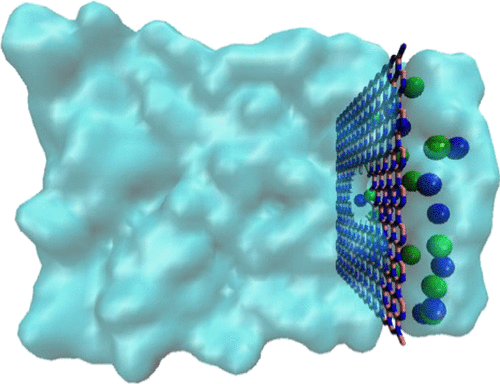Our official English website, www.x-mol.net, welcomes your
feedback! (Note: you will need to create a separate account there.)
High Water Flux with Ions Sieving in a Desalination 2D Sub-Nanoporous Boron Nitride Material
ACS Omega ( IF 3.7 ) Pub Date : 2018-06-12 00:00:00 , DOI: 10.1021/acsomega.8b01076 Xavier Davoy 1 , Alain Gellé 1 , Jean-Christophe Lebreton 1 , Hervé Tabuteau 1 , Armand Soldera 2 , Anthony Szymczyk 3 , Aziz Ghoufi 1
ACS Omega ( IF 3.7 ) Pub Date : 2018-06-12 00:00:00 , DOI: 10.1021/acsomega.8b01076 Xavier Davoy 1 , Alain Gellé 1 , Jean-Christophe Lebreton 1 , Hervé Tabuteau 1 , Armand Soldera 2 , Anthony Szymczyk 3 , Aziz Ghoufi 1
Affiliation

|
Over the past decades, desalination by reverse osmosis (RO) membranes has attracted increasing attention. Although RO has proven its efficiency, it remains, however, relatively costly because of the use of high-pressure pumps and the low water permeability of conventional cross-linked polymer membranes. One route to improve the desalination performance consists of using membranes made from sub-nanoporous boron nitride (sNBN) monolayers. Indeed, by using molecular dynamics simulations, we report here that the water permeability of such sNBN membranes far exceeds that of conventional RO polymer membranes and is even higher than that of nanoporous graphene while the ion rejection remains close to 100%. At the same time, the molecular mechanism of water and ion transport through sNBN has been elucidated, with special attention paid to the impact of ions on water permeability through sNBN membranes.
中文翻译:

脱盐2D亚纳米多孔氮化硼材料中离子筛分的高水通量
在过去的几十年中,通过反渗透(RO)膜进行脱盐已经引起了越来越多的关注。尽管RO已经证明了其效率,但是由于使用高压泵和常规交联聚合物膜的低水渗透性,RO仍然相对昂贵。改善脱盐性能的一种方法是使用由亚纳米多孔氮化硼(sNBN)单层制成的膜。确实,通过使用分子动力学模拟,我们在这里报告说,这种sNBN膜的透水性远远超过常规RO聚合物膜,甚至比纳米多孔石墨烯更高,而离子截留率却接近100%。同时,阐明了水和离子通过sNBN传输的分子机理,
更新日期:2018-06-12
中文翻译:

脱盐2D亚纳米多孔氮化硼材料中离子筛分的高水通量
在过去的几十年中,通过反渗透(RO)膜进行脱盐已经引起了越来越多的关注。尽管RO已经证明了其效率,但是由于使用高压泵和常规交联聚合物膜的低水渗透性,RO仍然相对昂贵。改善脱盐性能的一种方法是使用由亚纳米多孔氮化硼(sNBN)单层制成的膜。确实,通过使用分子动力学模拟,我们在这里报告说,这种sNBN膜的透水性远远超过常规RO聚合物膜,甚至比纳米多孔石墨烯更高,而离子截留率却接近100%。同时,阐明了水和离子通过sNBN传输的分子机理,











































 京公网安备 11010802027423号
京公网安备 11010802027423号